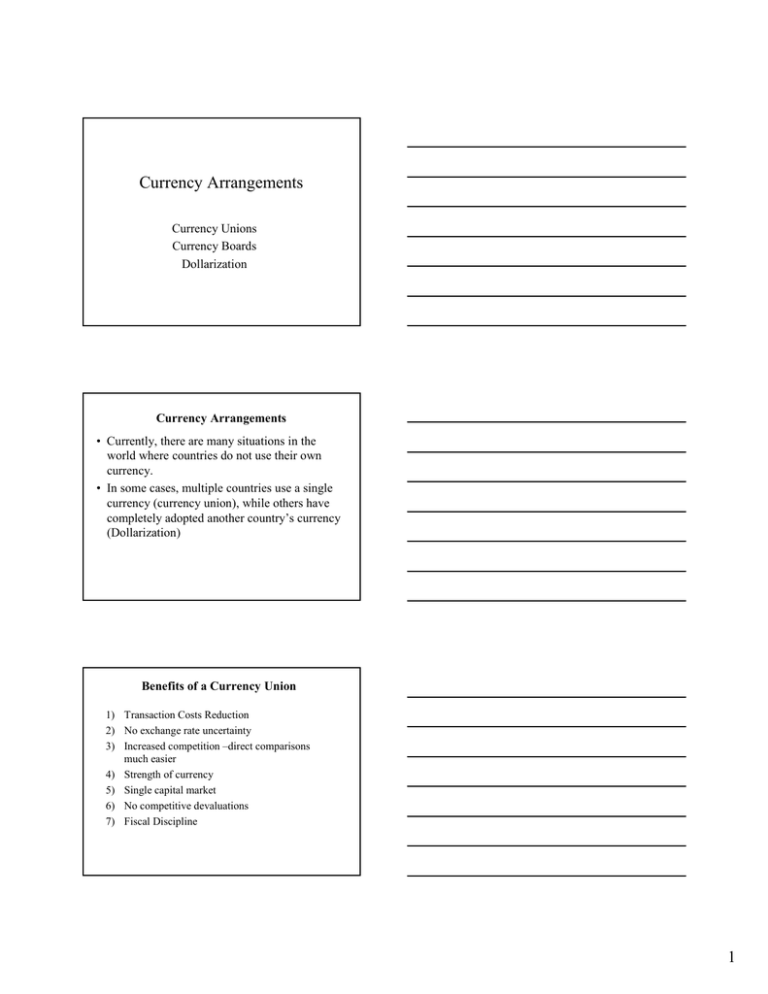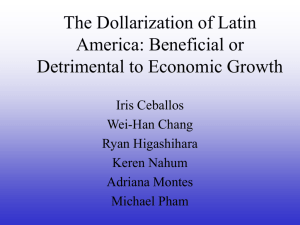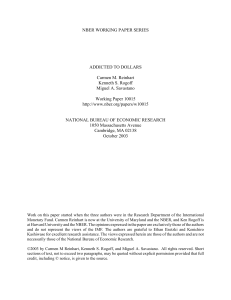Currency Arrangements
advertisement

Currency Arrangements Currency Unions Currency Boards Dollarization Currency Arrangements • Currently, there are many situations in the world where countries do not use their own currency. • In some cases, multiple countries use a single currency (currency union), while others have completely adopted another country’s currency (Dollarization) Benefits of a Currency Union 1) Transaction Costs Reduction 2) No exchange rate uncertainty 3) Increased competition –direct comparisons much easier 4) Strength of currency 5) Single capital market 6) No competitive devaluations 7) Fiscal Discipline 1 Costs of a Currency Union 1) 2) 3) 4) 5) Introduction Costs Non-synchronicity of Business Cycles Fiscal Policy Spillovers No competitive devaluations Central Bank Independence Optimal Currency Areas • Is Europe an “optimal currency area”, or should there be several “European” currencies? Should the US have more than 1 currency? • How does one decide whether or not countries should form a currency union? • 2 main criteria – Synchronicity of business cycles – Bilateral-trade intensities European Monetary Union • The EU origins are in the Treaty of Rome (1957) –6 original countries: BeNeLux, Italy, France, Germany – 1973: UK, Ireland, Denmark – 1981: Greece – 1986: Spain, Portugal – 1995: Austria, Finland, Sweden • Why form: Post-WWII BoP problems initiate tariff reduction and aid system 2 EU/EMU • Maastricht Summit (1991) – Economic and Monetary Union in 1999 – Goal: Single currency in 2002 (euro) • Prior to euro – ECU (European Currency Unit) – Ecu – artificial “basket” of currencies used by members – Created in 1979 when EU was EEC – Part of the European Monetary System European Monetary System (Pre-EMU) • “Limited Flexible Exchange Rate System” – exchange rate bands at 2.25% (wider for Italy) • Adjustable-Peg system • Not all European countries participated • When euro was introduced, ecu:euro exchange rate was set at 1:1. • Value of ecu: determined by a weighted value of the member countries own currencies European Monetary Union • Aspects of the EMU – Jan 2, 2002 – banknotes and coins in circulation – 11 countries participating • UK,Denmark,Sweden,Greece not members – European Central Bank created • Primary objective: maintain price stability • Very independent from member countries 3 Maastricht Criteria • 5 criteria to meet for EMU membership 1) Price stability (low inflation) 2) Fiscal prudence (Deficit and Debt) 3) Maintain stable ER (stay within EMS bounds) 4) Low long-term interest rates Dollarization • Dollarization occurs when a country adopts the currency of another country as its official currency. Usually, but not always, this is the US$. • This may occur as either “total” or as “partial” dollarization • Total Dollarization – the US dollar is made the only medium of exchange, store of value, and unit of account • Partial Dollarization – US dollars circulate alongside domestic currency • Why Dollarize? Countries are searching for ways to protect their economies from financial crises How Do Countries Dollarize? • Countries can dollarize in two ways 1) The foreign government makes a decision to replace its own currency with the US$ • • In total dollarization, US$ used for all transactions In partial dollarization, citizens can hold $denominated accounts 2) Citizens lose faith in their own currency and adopt the US$ as their own currency (de facto dollarization) • • Inflation/Hyperinflation pressures Political concerns 4 Benefits of Dollarization • What are the benefits of dollarization? – Eliminates the possibility of currency devaluation – Reduced capital flight? – Limit inflation – Lower interest rates – Reduced international transaction costs Costs of Dollarization • What are the costs to dollarizing? – Dollarizing country relinquishes monetary policy control to US Fed, whose policy mandate is domestic – Costly reversibility – can the country go back to its own currency? – Lost seigniorage revenue – Lost sovereignty Who Should Dollarize? • What are the criteria countries should examine when considering dollarization? – Is your country a small or large economy? – Is your country particularly vulnerable to international shocks? – Does your country have strong ties (trade, financial) with the US? Result: Many Latin and Central American countries have debated dollarization Panama: Dollarized since 1904 Ecuador: Dollarized since 2000 5





